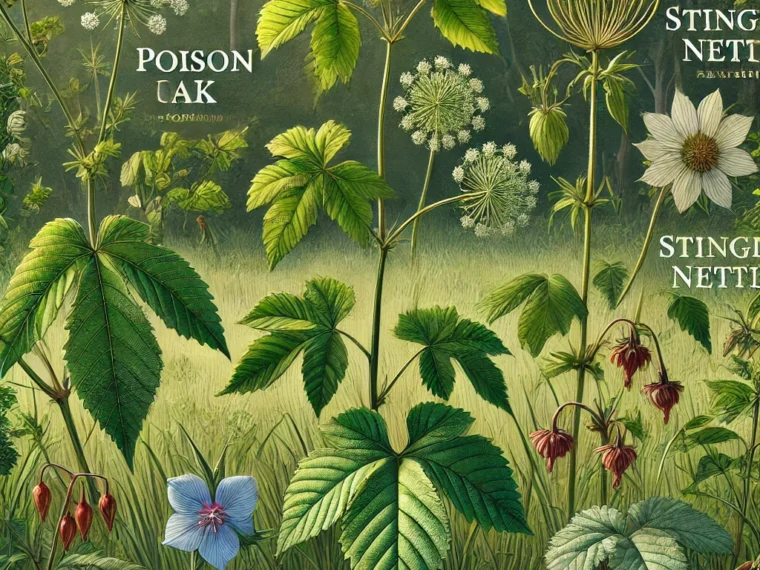Nature is full of beautiful and fascinating plants, but not all are as harmless as they appear. Some common plants, which might be growing in your garden, neighborhood, or the wild, can cause severe irritation and allergic reactions to the skin. Unfortunately, many people are unaware of these risks until they come into contact with them. Here’s a detailed guide to help you identify these plants, understand their effects, and learn how to protect yourself.
1. Poison Ivy
Scientific name: Toxicodendron radicans
Where it’s found: North America, primarily in wooded areas, gardens, and near hiking trails.
What to watch for:
- Poison ivy has three shiny green leaves that can turn red or yellow in the fall.
- It grows as a vine or shrub, and all parts of the plant contain an oily resin called urushiol, which causes skin irritation.
Skin Reaction:
- Contact with poison ivy can result in a red, itchy rash, swelling, and blistering within 12-48 hours.
- The rash is not contagious, but urushiol can linger on clothing, pets, and gardening tools, spreading the irritation.
Prevention & Treatment:
- Wear long sleeves, gloves, and pants when working outdoors.
- If you come into contact, immediately wash your skin with soap and cold water to reduce exposure.
- Use over-the-counter hydrocortisone creams or antihistamines to manage itching and swelling.
2. Poison Oak
Scientific name: Toxicodendron diversilobum
Where it’s found: Western United States, particularly in forests and dry, sunny areas.
What to watch for:
- Poison oak resembles poison ivy but has lobed or rounded leaf edges, similar to oak tree leaves.
- It grows as a bush or vine and turns bright red in fall.
Skin Reaction:
- Like poison ivy, poison oak contains urushiol, causing intense itching, redness, and blisters.
- The symptoms may persist for 1-2 weeks if untreated.
Prevention & Treatment:
- Avoid direct contact and ensure protective clothing when outdoors.
- Rinse your skin immediately if exposed, and wash contaminated clothing.
- For severe reactions, consult a doctor for prescription treatments.
3. Poison Sumac
Scientific name: Toxicodendron vernix
Where it’s found: Swampy, wet areas in the Eastern United States.
What to watch for:
- Poison sumac has 7-13 leaflets arranged on a reddish stem, with smooth edges and pointed tips.
- It grows as a tall shrub or small tree.
Skin Reaction:
- Contact with poison sumac leads to a severe rash, blistering, and itching, often worse than poison ivy or oak.
- Even burning poison sumac can release urushiol into the air, irritating the skin, lungs, and eyes.
Prevention & Treatment:
- Stay away from wetlands where poison sumac thrives.
- Follow the same precautions as with poison ivy and oak, including thorough washing.
- Seek medical care if breathing issues occur after exposure.
4. Stinging Nettle
Scientific name: Urtica dioica
Where it’s found: Found worldwide, especially in gardens, fields, and along riverbanks.
What to watch for:
- Stinging nettle has serrated leaves with fine, hair-like structures on the surface and stems.
- The hairs contain histamines and formic acid, which are released upon contact.
Skin Reaction:
- Touching stinging nettle causes immediate burning, itching, and redness, often accompanied by small raised bumps.
- The reaction is typically short-lived but can be very uncomfortable.
Prevention & Treatment:
- Wear protective gloves when gardening or hiking in areas where nettles grow.
- Wash the affected area with soap and water to remove the irritants.
- Use calamine lotion or aloe vera to soothe the skin.
5. Giant Hogweed
Scientific name: Heracleum mantegazzianum
Where it’s found: Europe, North America, and parts of Asia, particularly near rivers and roadsides.
What to watch for:
- Giant hogweed is a towering plant that can grow up to 15 feet tall, with large white umbrella-shaped flowers and thick, green stems with purple blotches.
- The plant contains phototoxic sap, which becomes active under sunlight.
Skin Reaction:
- Contact with hogweed sap causes severe burns, blistering, and skin discoloration when exposed to sunlight.
- The symptoms may appear within 24 hours and can leave long-lasting scars.
Prevention & Treatment:
- Avoid touching or removing giant hogweed without professional help.
- If exposed, wash the area thoroughly, stay out of sunlight, and seek medical attention immediately.
6. Wild Parsnip
Scientific name: Pastinaca sativa
Where it’s found: Common in fields, along roadsides, and in ditches across North America and Europe.
What to watch for:
- Wild parsnip resembles a yellow-flowered plant with tall stems and feathery leaves.
- Like hogweed, its sap is phototoxic.
Skin Reaction:
- Exposure to wild parsnip sap followed by sunlight can cause phytophotodermatitis. This leads to severe burns, red patches, and blisters that can take weeks to heal.
Prevention & Treatment:
- Avoid touching the plant directly; wear gloves and long sleeves when gardening.
- Wash the skin and keep it covered from sunlight if exposed.
How to Protect Yourself from These Plants
TO CONTINUE READING THE ARTICLE PLEASE SEE PAGE 2




